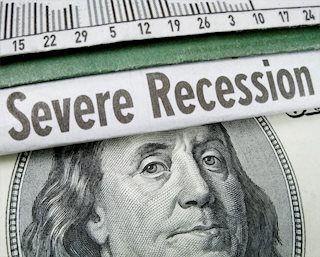Key indicator signals ‘recession ahead’: Fed faces pressure to cut rates
|
The mainstream financial media is reporting that inflation is coming down.
It’s not coming down to the Federal Reserve’s supposed 2% target – let alone low enough to cease being a persistent problem for millions of families. Nor is it even clear that the rate of price level increases is on a path lower in 2024.
According to William J. Luther of the American Institute for Economic Research:
Inflation picked up in January, according to the latest data from the Bureau of Economic Analysis (BEA). The Personal Consumption Expenditures Price Index (PCEPI), which is the Federal Reserve’s preferred measure of inflation, grew at a continuously compounding annual rate of 4.1 percent in the first month of the year.
The PCEPI has grown at an annualized rate of 1.8 percent over the last three months and 2.5 percent over the last six months. Prices today are 8.4 percentage points higher than they would have been had they grown at an annualized rate of 2.0 percent since January 2020.
Some categories of consumer prices are up much more than the overall official reading (which has been engineered by federal bureaucrats to understate food, shelter, healthcare, and other expenses).
For example, food stamp costs for family meals have jumped more than 30% over the past three years. Automobile insurance rates are up 26%. And rising housing costs continue to outpace income growth.
To the extent that consumer price increases do ease at all this year, it will be because the economy is slowing.
The latest manufacturing data releases suggest the industrial sector is seeing softening demand. States are starting to report rising levels of job losses. And consumers are growing more negative toward the economy.
The Conference Board reported last week that consumer confidence fell in February for the first time in three months. Americans’ expectations for income and business conditions saw a significant decline, falling below a threshold that “often signals recession ahead,” according to the Conference Board.
Contrary to how ordinary Americans are feeling about the economy, the Biden administration is trying to sell them the narrative that it’s gotten far better since he assumed office.
But judging by Joe Biden’s historically low approval rating, that narrative isn’t resonating with many voters.
The upshot is that pressure on the Fed to cut interest rates will likely grow between now and November.
When central bankers finally do relent and begin easing, the U.S. dollar can be expected to weaken in the currency market. That could be the catalyst precious metals markets need to move meaningfully higher.
Information on these pages contains forward-looking statements that involve risks and uncertainties. Markets and instruments profiled on this page are for informational purposes only and should not in any way come across as a recommendation to buy or sell in these assets. You should do your own thorough research before making any investment decisions. FXStreet does not in any way guarantee that this information is free from mistakes, errors, or material misstatements. It also does not guarantee that this information is of a timely nature. Investing in Open Markets involves a great deal of risk, including the loss of all or a portion of your investment, as well as emotional distress. All risks, losses and costs associated with investing, including total loss of principal, are your responsibility. The views and opinions expressed in this article are those of the authors and do not necessarily reflect the official policy or position of FXStreet nor its advertisers.